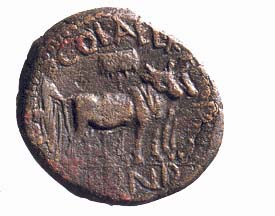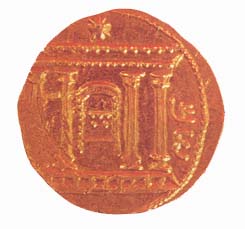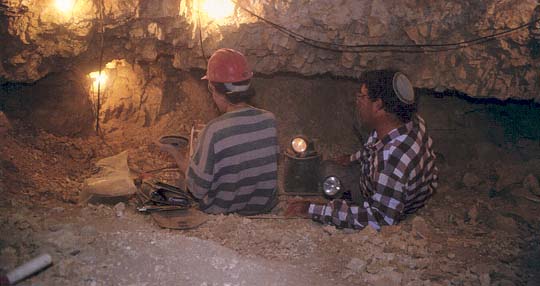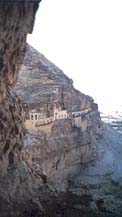046
046
Unlike the First Jewish Revolt against Rome (66–70 C.E.), which was chronicled in detail by the first-century historian Josephus, the Second Jewish Revolt, the so-called Bar-Kokhba Revolt (132–135 C.E.), is known only from scraps of ancient literature.1 Archaeology alone can fill in the gaps. And it has been doing so in an amazing way in recent decades.a
One of the mysteries surrounding the revolt involves the founding of the city Aelia Capitolina, the name the Romans gave to Jerusalem. Did the Romans establish Aelia Capitolina before the Bar-Kokhba Revolt, thereby inciting the Jews to revolt? Or did they establish it after the revolt and exclude the Jews from the city as punishment? Scholars, as might be expected, have taken two views. Recent numismatic evidence—coins from the Judean desert—may provide the answer.
The first view, that the founding of Aelia Capitolina preceded the revolt, is supported by the Roman historian Dio Cassius. In 130 C.E. Emperor Hadrian (117–138 C.E.) made a tour of his eastern lands, traveling through Judea, Arabia and Egypt before returning to Rome. According to Dio, Hadrian founded Aelia Capitolina during this journey.2
The church historian Eusebius, however, describes the transformation of Jerusalem into Aelia Capitolina as occurring after the Bar-Kokhba Revolt was crushed, in 136 C.E.3
The Mishnah, the earliest rabbinic classic, redacted in about 200 C.E., seems to support Eusebius. In Ta’anit 4.6, the Mishnah lists five disasters that occurred on the ninth of the Hebrew month of Av, including the Babylonian destruction of the First Temple and the Roman destruction of the Second Temple. The fourth item in the list is the fall of Betar, the last stronghold of Bar-Kokhba’s warriors, which ended the Second Jewish Revolt. The final item in the Mishnah’s list is the plowing of “the city”—that is, Jerusalem. When the Romans founded a city, they fixed its boundaries in a ceremonial ritual in which an ox and a cow, tethered together, plowed a line that marked the new city’s limits. That the Mishnah lists the fall of Betar before the founding of Roman Jerusalem seems to confirm Eusebius’s statement that Aelia Capitolina was founded after the Bar-Kokhba revolt was suppressed.
Who was right—Dio Cassius or Eusebius?
Like the rebels of the First Jewish Revolt, the Jews of the Second Jewish Revolt issued their own coins. These may help us answer the question. The Second Revolt coins are all overstrikes; that is, the rebels took coins then in circulation and imprinted them with their own impressions. Rome issued coins commemorating Aelia Capitolina. If an Aelia Capitolina coin had been found overstruck with a Bar-Kokhba impression, this would provide clear evidence that Aelia had been founded before the revolt. However, since no such coin has been found, some scholars have assumed that Aelia was established after the revolt, as punishment.


In 1967 a hoard of coins that was said to have been illegally excavated in the northern part of the Judean desert surfaced on the antiquities market. The hoard included Bar-Kokhba coins and an Aelia Capitolina coin. This seemed to indicate that Aelia was founded before the revolt, since the refugees who supposedly hid the coins during the revolt also had an Aelia coin.
Later, in 1970, hoards said to have come from the same area appeared on the market. These too contained a mixture of Bar-Kokhba and Aelia coins. As Yaakov Meshorer, the dean of Israeli numismatists, noted, these discoveries seemed to support Dio’s testimony that Aelia was founded in 130 C.E., during Hadrian’s eastern tour.
There was a problem, however. These hoards were found not in professional digs but in illegal excavations. Local Bedouin regularly engage in such digs and then sell their finds to antiquities dealers. Some skeptical scholars have 047suggested that antiquities dealers may have added the Aelia coins to the hoards to increase their value.
I can now report the controlled and legal excavation of a hoard of coins that may remove any doubts.
This excavation is really part of a larger story involving the search for and excavation of caves in the Judean desert. Many of these caves were used by Jewish refugees fleeing from the Roman forces during the Second Revolt.b Since 1951, 27 Second Revolt refugee caves have been identified. Eight of these caves have been 048found by the Israel Cave Research Center (ICRC), established in 1979 by the Israel Society for the Protection of Nature. All of these caves can be dated to the Bar-Kokhba period by the finds—pottery, glass, keys, wooden combs and bronze vessels as well as coins. In most of the caves, unfortunately, archaeologists detected evidence of prior illegal excavation. Nevertheless, important finds awaited discovery.


In one cave that was clearly a Jewish refuge during the revolt (the Araq el-Na’asaneh Cave), ICRC volunteers found 16 silver denarii struck by the emperors Trajan (98–117 C.E.) and Hadrian, as well as one tridrachma from the Roman province of Cappadocia. This demonstrates that the Jewish rebels did not overstrike all the coins they got hold of but continued to use Roman coins bearing their original impressions.
In 1986, I excavated a cave (known as the Abi’or Cave) to which 38 people had fled. We found their skeletons in the cave. They probably suffocated as a fire kindled by the Romans at the entrance withdrew oxygen from the cave. Five documents written on papyrus (three in Greek and two in Aramaic) indicate that the people fled to the cave in 135 C.E. Some of these documents were found on a terrace located at the entrance to the cave. However, the stratigraphy was reversed. Usually, as archaeologists dig deeper, they reveal earlier and earlier strata, or layers of occupation. But near the mouth of the Abi’or Cave, we found a fourth-century B.C.E. document above three documents from the Roman period. This indicates that some later occupants dumped the cave’s contents onto the terrace, thereby turning the strata upside down. It is not difficult to determine who did this: monks who lived in this cave during the 14th century.
In 1987 I excavated another refugee cave, which yielded one bronze coin that had been overstruck by the rebels and a silver dinar of Hadrian, further proof that the rebels continued to use some regular Roman coins.
In 1991 David Amit, an archaeologist with the Israel Antiquities Authority, and I excavated a cave that yielded a tetradrachma of Bar-Kokhba with the facade of the destroyed Jerusalem Temple on the obverse. About 2,000 of these coins are known, but this tetradrachma is the first to be discovered during a legal excavation. We named the findspot the Cave of the Tetradrachma.
Finally, I come to the el-Jai Cave, on the south side of Wadi Suweinet, northeast of Jerusalem. I visited the cave several times, looking for artifacts from the Bar-Kokhba Revolt, but found only some Early Bronze Age potsherds (c. 2000 B.C.E.). When I led a group of students here in 1997, we found evidence of intensive illegal excavations. Near one of the cave’s two entrances we noticed potsherds from the second century C.E. Crawling into the inner part of the cave, we came upon broken glass vessels, often found in destruction layers from the Bar-Kokhba period. We also found two coins near the entrance to the cave’s huge hall and three more inside.
The oldest was a bronze coin of the Roman emperor Domitian (81–96 C.E.), minted in Sebaste, with two countermarks (stamps) of the Tenth Roman 073Legion. (This legion led the forces that suppressed the First Jewish Revolt against Rome in the first century C.E.) The other four coins all dated to the time of Hadrian. Three of these coins are critical to our discussion: a city coin from Gaza, found in the huge hall, and two Aelia Capitolina coins, from a tunnel leading into the hall.
The Gaza coin is important because it can be dated precisely. When Hadrian made his eastern tour, he visited Gaza, an honor the city wanted to preserve in memory forever. To do this, the Gazans recorded two dates on their coins: the Gaza era (the number of years from the Roman liberation of the city in 61 B.C.E.) and the number of years after Hadrian’s visit. The inscription on the Gaza coin from the el-Jai Cave tells us it was struck in year 5 after the visit of Hadrian and year 194 of the Gaza era. This double date (the difference between the two dates is seven or eight months) allows the coin to be dated to the end of 133 C.E. or the beginning of 134 C.E.
One of the Aelia Capitolina coins portrays, on its reverse, the ceremony of the founding of the city as a Roman colony. The emperor appears plowing the boundary of the city with an ox and a cow. The Latin inscription reads “COL[ONIA] AEL[IA] KAPIT[OLINA], COND[IT],” or “Colony of Aelia Capitolina, founded.” In the background is the legionary standard. The other Aelia coin depicts, on its reverse, the head of Sabina, Hadrian’s wife, with the inscription “Sabina Augusta.” Both coins strengthen the association of the founding of Aelia with Hadrian’s tour, especially his visit to Jerusalem.

If, as I believe, the Gaza coin was deposited in the cave at the same time as the Aelia coins, Aelia must have been founded by 133/4 C.E. The Bar-Kokhba Revolt lasted another year or so. Therefore Aelia must have been established before, not after, the revolt. Dio Cassius was right. The establishment of Jerusalem as a Roman colony named Aelia Capitolina was apparently one of the causes of the Second Jewish Revolt against Rome.
One final insight provided by the coins from this cave: Some scholars have argued that the rebels had no commercial connections with people outside Judea during the revolt. Their argument is based largely on the fact that coin hoards from the Bar-Kokhba Revolt usually contain no Roman coins dating later than 132 C.E. The coins from the el-Jai Cave disprove this contention. The Jews who fled to this cave no earlier than 134 C.E. carried with them coins minted in 133/4 C.E.—during the revolt.
Unlike the First Jewish Revolt against Rome (66–70 C.E.), which was chronicled in detail by the first-century historian Josephus, the Second Jewish Revolt, the so-called Bar-Kokhba Revolt (132–135 C.E.), is known only from scraps of ancient literature.1 Archaeology alone can fill in the gaps. And it has been doing so in an amazing way in recent decades.a One of the mysteries surrounding the revolt involves the founding of the city Aelia Capitolina, the name the Romans gave to Jerusalem. Did the Romans establish Aelia Capitolina before the Bar-Kokhba Revolt, thereby inciting the Jews to revolt? Or did they […]
You have already read your free article for this month. Please join the BAS Library or become an All Access member of BAS to gain full access to this article and so much more.
Already a library member? Log in here.
Institution user? Log in with your IP address or Username
Footnotes
See, for example, Amos Kloner, “Underground Metropolis—The Subterranean World of Maresha,” BAR 23:02.
See the following articles in the September/October 1989 BAR: Joseph Patrich, “Hideouts in the Judean Wilderness—Jewish Revolutionaries and Christian Ascetics Sought Shelter and Protection in Cliffside Caves,” BAR 15:05 and Hanan Eshel, “How I Found a Fourth-Century B.C. Papyrus Scroll on My First Time Out,” BAR 15:05.
